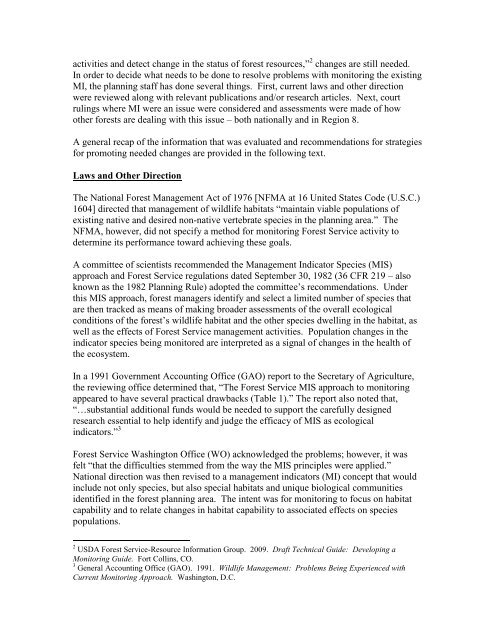A White Paper Discussing Management Indicator Species (MIS)
A White Paper Discussing Management Indicator Species (MIS)
A White Paper Discussing Management Indicator Species (MIS)
Create successful ePaper yourself
Turn your PDF publications into a flip-book with our unique Google optimized e-Paper software.
activities and detect change in the status of forest resources,” 2 changes are still needed.<br />
In order to decide what needs to be done to resolve problems with monitoring the existing<br />
MI, the planning staff has done several things. First, current laws and other direction<br />
were reviewed along with relevant publications and/or research articles. Next, court<br />
rulings where MI were an issue were considered and assessments were made of how<br />
other forests are dealing with this issue – both nationally and in Region 8.<br />
A general recap of the information that was evaluated and recommendations for strategies<br />
for promoting needed changes are provided in the following text.<br />
Laws and Other Direction<br />
The National Forest <strong>Management</strong> Act of 1976 [NFMA at 16 United States Code (U.S.C.)<br />
1604] directed that management of wildlife habitats “maintain viable populations of<br />
existing native and desired non-native vertebrate species in the planning area.” The<br />
NFMA, however, did not specify a method for monitoring Forest Service activity to<br />
determine its performance toward achieving these goals.<br />
A committee of scientists recommended the <strong>Management</strong> <strong>Indicator</strong> <strong>Species</strong> (<strong>MIS</strong>)<br />
approach and Forest Service regulations dated September 30, 1982 (36 CFR 219 – also<br />
known as the 1982 Planning Rule) adopted the committee’s recommendations. Under<br />
this <strong>MIS</strong> approach, forest managers identify and select a limited number of species that<br />
are then tracked as means of making broader assessments of the overall ecological<br />
conditions of the forest’s wildlife habitat and the other species dwelling in the habitat, as<br />
well as the effects of Forest Service management activities. Population changes in the<br />
indicator species being monitored are interpreted as a signal of changes in the health of<br />
the ecosystem.<br />
In a 1991 Government Accounting Office (GAO) report to the Secretary of Agriculture,<br />
the reviewing office determined that, “The Forest Service <strong>MIS</strong> approach to monitoring<br />
appeared to have several practical drawbacks (Table 1).” The report also noted that,<br />
“…substantial additional funds would be needed to support the carefully designed<br />
research essential to help identify and judge the efficacy of <strong>MIS</strong> as ecological<br />
indicators.” 3<br />
Forest Service Washington Office (WO) acknowledged the problems; however, it was<br />
felt “that the difficulties stemmed from the way the <strong>MIS</strong> principles were applied.”<br />
National direction was then revised to a management indicators (MI) concept that would<br />
include not only species, but also special habitats and unique biological communities<br />
identified in the forest planning area. The intent was for monitoring to focus on habitat<br />
capability and to relate changes in habitat capability to associated effects on species<br />
populations.<br />
2<br />
USDA Forest Service-Resource Information Group. 2009. Draft Technical Guide: Developing a<br />
Monitoring Guide. Fort Collins, CO.<br />
3<br />
General Accounting Office (GAO). 1991. Wildlife <strong>Management</strong>: Problems Being Experienced with<br />
Current Monitoring Approach. Washington, D.C.
















